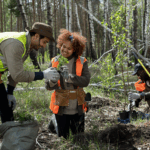

After a disaster, nonprofits show up.
They feed people. They distribute supplies. They check on elders. They do wellness checks. They translate briefings. They fill out FEMA applications. They patch holes in the system—fast.
But too often, once the dust settles and the long road begins, nonprofits get pushed to the side.
Government agencies start building their recovery plans. Funders shift focus to large-scale reconstruction. The language turns technical. The process gets bureaucratic. And slowly, the people who carried the community in the early weeks get sidelined from the long-term work.
That’s a huge mistake.
Because here’s the truth: nonprofits aren’t just helpful—they’re recovery infrastructure.
And treating them like afterthoughts holds everyone back.
What Happens When You Marginalize Nonprofits in Recovery
When nonprofits are left out of formal recovery planning, you get ripple effects across the whole system:
Programs are designed without frontline insight—so they miss the mark
Community trust erodes, because the most visible helpers aren’t part of the strategy
Gaps go unfilled, or get filled haphazardly without coordination
Government and funders operate in a silo, disconnected from real-time need
Nonprofits burn out trying to keep up with emerging demands, without stable support
And the longer that goes on, the harder it is to bring everyone back to the table.
What It Means to Treat Nonprofits as Infrastructure
If you’re serious about an inclusive, effective recovery, you have to treat nonprofit organizations as essential operating partners—not just nice-to-haves.
That means:
Planning with them, not just for them. They should be in the room during needs assessments, strategy development, and funding conversations.
Resourcing them with intention. Not just through one-time grants, but by investing in their capacity to do long-term work.
Formalizing coordination. Create regular, structured space for nonprofits to plug into the same coordination systems as government and funders.
Listening to what they’re seeing on the ground. They often have faster, clearer insight into emerging needs than anyone else.
What Local Governments Often Miss
From the local government side, here’s what often happens:
You’re overwhelmed and understaffed
You’ve got federal deadlines and reporting requirements to juggle
You assume nonprofits will “keep doing what they do” in the background
You send them a grant opportunity every few months and call that support
But if that’s your approach, you’re likely missing their full potential—and exposing your own gaps.
Remember: nonprofits are often the only part of the system with direct lines to survivors, day in and day out. They know who’s struggling. They hear the confusion. They translate the policies. They deliver the actual outcomes.
If you’re not using that insight to inform your plans, you’re not just being exclusionary—you’re building blind.
What Nonprofits Need From Recovery Leaders
It’s not just about inviting nonprofits to your meetings. It’s about giving them real partnership. That includes:
Transparency. Share what’s known, what’s changing, and what’s still uncertain—even if it’s messy.
Flexibility. Many nonprofits can do extraordinary things—but rigid scopes, short timelines, and complicated reimbursement rules can choke their ability to act.
Trust. Nonprofits don’t need a chaperone. They need respect, open communication, and a seat at the table where decisions are made.
Operational support. Funders and governments love to fund programs—but rarely fund overhead, staff retention, or system upgrades. Without this support, nonprofits burn out or collapse just when they’re most needed.
Building a Recovery Model That Includes Nonprofits From the Start
Here’s what it looks like to embed nonprofits into the core of your recovery operation:
Shared Tables. Create space for nonprofits to join recovery coordination meetings as equal partners, not observers.
Joint Needs Assessments. Use nonprofit insight to validate or adjust formal data from FEMA, HUD, or economic impact studies.
Navigator Programs. Pair local nonprofits with recovery navigators to help connect residents to federal and state resources.
Flexible Grant Programs. Structure funding with flexible, outcome-based deliverables that account for real-world conditions—not just perfect documentation.
Capacity Investment. Use early philanthropic dollars or local appropriations to strengthen key nonprofit partners for the long haul—not just short-term service delivery.
This isn’t one-sided. Nonprofits also need to be ready to operate as part of a coordinated system. That means:
Designate a point person for recovery coordination
Be transparent about what you can and can’t do
Document what you’re seeing—even if it’s informal
Show up consistently, even when you’re tired
Tell the truth when the strategy isn’t working
Advocate for flexibility and realism, not just funding
Being treated like infrastructure comes with responsibility—and nonprofits are often more than ready for that role. They just need an open door.
After a major fire, a small local nonprofit started hosting weekly dinners for displaced families in a church basement. No funding. No fanfare. Just food, hugs, and an open mic for updates.
Within weeks, the dinner became the community’s unofficial recovery hub.
Case managers showed up. Permitting staff joined. Mental health providers came.
It wasn’t a formal program. But it was the only space where survivors felt safe asking real questions.
That nonprofit didn’t just provide meals—they provided stability, continuity, and trust.
And that made all the difference.
Final Thought: If You Want Real Recovery, You Need Real Partners
You can’t coordinate recovery from a spreadsheet.
You can’t rebuild trust from behind a podium.
And you can’t deliver whole-community recovery without the people who were already there—doing the work long before the cameras arrived.
Nonprofits aren’t on the sidelines. They’re on the frontlines.
And if you want to go the distance, you need them in the core.
Explore our full training catalog for lessons and tools that help you plan smarter, coordinate across layers, and lead recovery on timelines that reflect the real world—not a spreadsheet.



